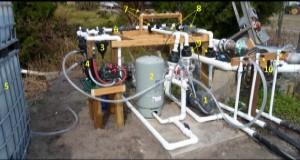Abstract
This article is intended to provide information to producers and Extension agents that are interested in using drip irrigation for vegetable production. Cabbage production in Florida is dominated by the use of seepage or sub-irrigation. This system has traditionally been used because it is inexpensive to maintain and simple to use. Seepage irrigation works by damming tail water ditches, pumping water into open furrows, and effectively raising the water table to a depth accessible to the crop root system (For more information see EDIS Publication #HS1217). This type of irrigation practice is almost completely unique to Florida and is possible due to the persistence of a shallow, impermeable layer in the soil profile. This system can require vast quantities of water to be pumped from the aquifer in low-rainfall years. Plasticulture, or the use of drip irrigation and plastic mulch, has been proposed as an alternative production method for cabbage production in Florida.
An on-farm demonstration was set up to provide a platform for collaboration between researchers, growers, and Extension professionals. The demonstration was located on Greene’s Farms in Bunnell, FL. The goal of the demonstration was to grow high-density cabbage populations using plasticulture side by side with seepage on a commercial farm. Fertilizer and irrigation management was closely matched between systems. The plasticulture system was designed to provide a small-scale installation of this technology for learning and commercial adaptation purposes. This small-scale system has great potential for encouraging adoption of this type of system with low risk to the grower.
This article illustrates an innovative approach for converting from seepage irrigation to plasticulture and points out some options and challenges for growers considering a plasticulture system.
Unless otherwise specified, articles published in the EDIS journal after January 1, 2024 are licensed under a Creative Commons Attribution-NonCommercial-NoDerivs 4.0 International (CC BY-NC-ND 4.0) license.

